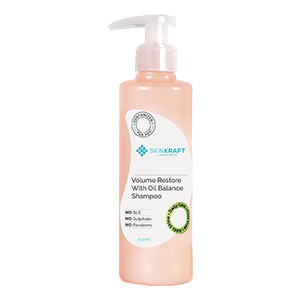Going bald as you age is a natural phenomenon. While there’s nothing to be ashamed of, does it upset you because you’re too young for a receding hairline? Has it taken a toll on your confidence? We’re here to help.
Most men show visible signs of a receding hairline in their 30s. However, there are ways to combat it or slow it down effectively. Read on to know about all the available OTC medicines, shampoos, serums and home remedies for a receding hairline.
Highlights:
What Is A Receding Hairline?
Receding hairline [1] is hair thinning occurring above the forehead, which is common in men and is mainly age related. Women can also experience receding hairline.
A receding hairline first starts at the temples (the area between the eye and the ear at the side of the head). Because hair is still present near the forehead, a V-shaped hair patch is formed called the 'widow's peak'.
In women, usually temples are not affected and hair thinning begins from the forehead. They may also not have receding hairlines necessarily, but can experience a decrease in hair density. There can be hair thinning throughout the scalp.
Receding Hairline Stages
Receding hairline in men can start as early as they finish puberty. However it is most common in late 20s and 30s. In women, receding hairline usually starts much later.
Dr. Zeel Gandhi, one of the doctors at SkinKraft, explains that receding hairline doesn't really end. It keeps receding until it merges with the bald patch on the crown and until the hair is left only above the ears and neck.
Receding hairline is the first sign of male pattern baldness. The norwood scale [2] classifies the male pattern baldness on a scale of 1-7.
- Stage 1 - It has little to no signs. Most common sign is a receding hairline that has just begun.
- Stage 2 - Receding hairline occurs at the temples.
- Stage3 - Receding hairline moves backwards giving an 'M' shape and is now quite evident.
- Stage 4 vertex - During this stage, some people experience balding at the top of the head in a small spot.
- Stage 5 - Hair loss is significant and may seem like a 'U' formation when seen from above.
- Stage 6 - The receding hairline progresses towards the back of the head.
- Stage 7 - The front part and crown part is completely bald by this stage.
- Stage 8 - Hair loss is seen at the sides of the head too.
What Causes Receding Hairline?
1. Hormones
A hormone called DHT (Dihydrotestosterone) [3] is produced as a by product of male sex hormone testosterone. It is responsible for male secondary sex characteristics like the body hair. This hormone can make your hair follicles [4] shrink to an extent that they can no longer grow hair. Male pattern baldness is directly related to the activity of DHT.
2. Family History
Receding hairline can be blamed on family history too. If your parents or grandparents have had it, there are chances that you may have it too.
3. Stress
Stress sends out signals to the scalp cells to mess up the hair growth cycle. Anxiety and stress contribute to a receding hairline. Turn to yoga, meditation or anything that can calm your mind. See how your hair begins to re-grow once you have managed to keep your mind at peace.
4. Smoking
Smoking in itself is a health hazard. What you probably didn't know was that smoking can cause a receding hairline. Yes, the toxins in smoke can interfere with your hair follicles and make the hair fall out [5].
5. Hairstyles
Being harsh on your hair with the heat styling, coloring chemicals, bleaching and tight hairstyles can all contribute to a receding hairline. The hydrogen peroxide [6] in your bleach not only fades away melanin pigment, but also makes hair shed faster.
6. Dandruff
Dandruff [7] presents itself in the form of white or yellow flakes on the scalp that may fall off on the shoulders. It is caused due to dry skin, fungi, sensitivity to hair care products, psoriasis or eczema. While dandruff directly does not cause a receding hairline, the itching and scratching can weaken the hair follicles and cause the hair to fall out.
7. Telogen Effluvium
Telogen effluvium [8] is a scalp condition where hair enters the resting phase of the telogen phase prematurely due to factors like stress, shock, hormonal changes or dietary deficiencies.
Generally 5-10% of hair on the scalp is in the resting phase on any given day. That is why we experience hair loss (50-100 strands), which is considered normal. But in telogen effluvium, about 30% of hair is in the resting phase. This condition may contribute to a receding hairline.
How To Slow Down A Receding Hairline?
1. Over-The-Counter Medication
Minoxidil [9] or rogaine is the most common over-the-counter (OTC) medicine for a receding hairline. Consult your doctor for the percentage of minoxidil you should opt for. It is applied topically on the scalp during bedtime. Studies have shown hair growth within a few weeks of application.
Finasteride [10] or propecia is a prescription medication that lowers the hormones which cause receding hairline. Oral form of finasteride has demonstrated hair growth on the scalp.
Anthralin [11] is another prescription medication that can encourage hair growth. It is often used to grow back the hair lost due to psoriasis.
Corticosteroids are another class of medication that can help reduce the inflammation around hair follicles and stimulate hair growth. However, corticosteroids may have side effects. Talk to your doctor before you consider them for your receding hairline.
2. Hair Transplant
Hair transplantation involves moving the hair at the back of your head to the front. The implanted hair gives a fuller appearance. Talk to your dermatologist to weigh the risks, if any. While hair transplantation can burn a hole in your pocket, it seems like a long term solution for a receding hairline.
3. Laser Treatment
The laser or light in laser therapy signals your cells to start the anagen phase (growth phase) of hair. Laser therapy is non-invasive and painless. You may need several sessions to witness hair re-growth.
4. Scalp Massage
Scalp massage provides blood circulation to the scalp and stimulates the hair follicles to produce hair. Use your fingertips to gently massage your scalp for 10 minutes everyday. You can do this while applying oil or while shampooing your hair.
5. Cosmetic Shampoos
The DHT (dihydrotestosterone) binds to the receptors on your scalp and causes hair loss. Use a DHT blocker shampoo to prevent the activity of DHT.
Look for shampoos that contain ketoconazole - an ingredient that stimulates hair growth.
Chemicals like alcohol, fragrances, dyes and sulfates in your shampoos strip off the natural oil or sebum from your scalp. So, it is crucial to use shampoos and conditioners that do not mess up your scalp and hair follicles.
6. Essential Oils
Essential oils like rosemary, lavender and peppermint oil are believed to help in hair regrowth at the forehead area. Since these have medicinal properties, never apply them directly to the scalp. Mix with a carrier oil like coconut or olive oil first.
7. Home Remedies
Many herbal remedies exist for a receding hairline. Ingredients like gooseberry, ginseng, aloe vera and chinese hibiscus are all effective against hair loss.
Mix one of these herbs in a carrier oil like coconut or olive oil and apply it on your scalp. Continue this a few times a week until you see visible results. Castor oil is also an effective remedy against receding hairline as it improves blood circulation and promotes hair growth.
8. Diet
Eating a diet rich in antioxidants, vitamins, minerals and protein can make your hair look healthier and fuller.
Antioxidants [12] are compounds that fight oxidative stress. Oxidative stress is triggered by factors like sunlight, pollution, stress and smoking. It produces free radicals (atoms or molecules containing unpaired electrons) that cause damage to your body including your hair follicles on the scalp.
Include a lot of greens, nuts, eggs, meat, omega 3 fatty acids, berries and beans in your diet for healthy hair. Cashews and almonds can help decrease Dihydrotestosterone (DHT) hormone in your body that triggers receding hairline.
Wrapping Up
Receding hairline cannot be reversed completely. But with all the above treatments, it can be slowed down. If you experience extreme hair loss, bald spots, patchiness and other unusual scalp and hair symptoms, consult your doctor immediately. Sudden hair loss, where hair falls out in clumps, may signify an underlying health issue.
1. https://medlineplus.gov/ency/article/001177.htm
2. https://www.ncbi.nlm.nih.gov/pmc/articles/PMC4812885/
3. https://www.ncbi.nlm.nih.gov/books/NBK278957/
4. https://www.ncbi.nlm.nih.gov/books/NBK470321/
5. https://www.ncbi.nlm.nih.gov/pubmed/12673073
6. https://www.cdc.gov/niosh/topics/hydrogen-peroxide/default.html
7. https://www.ncbi.nlm.nih.gov/pmc/articles/PMC2887514/
8. https://www.ncbi.nlm.nih.gov/books/NBK430848/
9. https://www.ncbi.nlm.nih.gov/pmc/articles/PMC6691938/
10. https://www.ncbi.nlm.nih.gov/pubmed/9951956
Recommended Products
Was this Article helpful?
- Least helpful
- Most helpful











